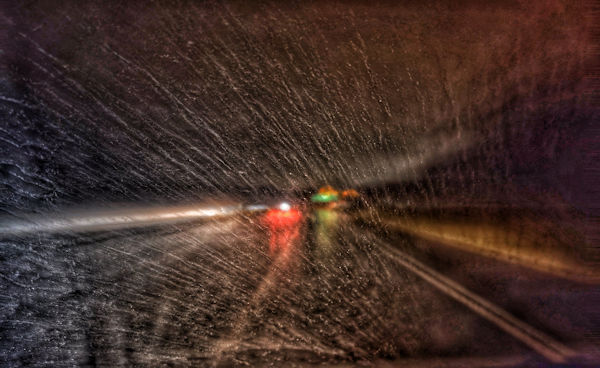SEJournal Online is the digital news magazine of the Society of Environmental Journalists. Learn more about SEJournal Online, including submission, subscription and advertising information.
 |
| Extreme precipitation driven by climate change means environmental journalists need ever more rainfall data. Above, navigating a highway in a downpour. Photo: James Loesch, Flickr Creative Commons. Click to enlarge. |
Reporter’s Toolbox: Making A Hard Rain Less Hard To Cover
By Joseph A. Davis
Thanks to climate change, the old adage needs an update: When it rains, it really, really pours.
The problem of extreme precipitation intensified by climate change is a problem not just for flooded communities, but also for environmental journalists, who increasingly find themselves wanting rainfall data more urgently than an umbrella.
Help is on the way. Up to a point.
Climate nerds might be intrigued by Lauren Sommer’s astute and provocative piece for NPR earlier in February about the problems obsolete rainfall records are causing for stormwater engineers these days. It was substantial and on the money.
But if you finish it thinking that environmental reporters can’t get rainfall data, you are all wet. We are drowning in it.
Future rainfall challenging to predict
Environmental journalists are not stormwater engineers, of course. The latter may need a data product that gives a probabilistic estimate of maximum rainfall 100 years from now. Journalists, on the other hand, are likelier to be asking how much rain fell in that monster storm this weekend or what kind of climate change Armageddon we can expect in 2050.
First, remember that weather observations are not the same as weather predictions. Nor is weather the same as climate.
The average and, indeed, past numbers
tell us little about what the numbers will be
next year or ten years into the future.
In the good old days, meteorologists just averaged out the numbers for the past 30 years and called that “climate.” But as the world undergoes climate change, this method is less meaningful. The average and, indeed, past numbers tell us little about what the numbers will be next year or ten years into the future.
One result: frustrated stormwater sewer engineers and floodplain managers.
No matter how skillful you (or your computer) are at predicting climate, the correct prediction depends on what actions we (consumers, companies, governments, farmers, etc.) take today and tomorrow. Those actions are still, to a larger extent, unknowns, and ones many are still trying to change.
The data landscape
When it comes to the data, it’s worth exploring the National Centers for Environmental Information, or NCEI, the organizational home and hub of much of the nation’s (and the world’s) climate data.
NCEI is a branch of the National Oceanic and Atmospheric Administration, which is also the home of the National Weather Service. The NWS operates or supervises most of the nation’s official rain gauges.
The NWS — and ultimately the NCEI — collects and stores the data from the gauges at individual stations. These stations also measure snowfall and other kinds of precipitation.
The NCEI actually archives data from all over the world (via channels like the World Meteorological Organization) and over historical time scales, which makes it important for analyzing climate (long-term) trends.
These same data are collected, analyzed and published by commercial weather services, such as The Weather Channel, AccuWeather or Weather Underground. These companies also have their own instruments.
Commercial weather outlets have certain advantages: they are forecast-oriented, they are localized, they are user-friendly and they are fast. There is a time lag in data that goes to NCEI.
Using the data smartly
In any case, it is good to figure out — ahead of time — the NWS office that issues observations and predictions for your area of interest.
You can try a map of NWS weather forecast offices. The ZIP code lookup tool is even handier — enter a city, state or zip code of interest from this page or this page.
For bigger storms, especially after the fact, you might want to explore NCEI’s storm events database.
NOAA does try to be helpful to people looking for precipitation and climate data. If you are still not finding what you are looking for, try its climate data online page or the NWS daily precipitation data page.
[Editor’s Note: For more from SEJournal, see reports on environmental concerns with extreme rain and combined sewer overflows, extreme rain creates worrying dam safety issues and rain-driven floods at Superfund sites, as well a Backgrounder on covering hurricane-related rains. Read an interview with a journalist who literally wrote the book on rain. Plus, find more on climate attribution science and predicting extreme weather, a TipSheet on staying safe while covering extreme rainfall in the field and a special report on covering climate and rain in the southern United States.]
Joseph A. Davis is a freelance writer/editor in Washington, D.C. who has been writing about the environment since 1976. He writes SEJournal Online's TipSheet, Reporter's Toolbox and Issue Backgrounder, and curates SEJ's weekday news headlines service EJToday and @EJTodayNews. Davis also directs SEJ's Freedom of Information Project and writes the WatchDog opinion column.
* From the weekly news magazine SEJournal Online, Vol. 7, No. 8. Content from each new issue of SEJournal Online is available to the public via the SEJournal Online main page. Subscribe to the e-newsletter here. And see past issues of the SEJournal archived here.














 Advertisement
Advertisement 



